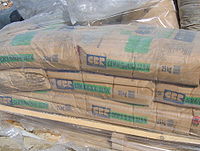
Photo from wikipedia
The depletion of natural resources of river sand and its availability issues as a construction material compelled the researchers to use manufactured sand. This study investigates the compressive strength of… Click to show full abstract
The depletion of natural resources of river sand and its availability issues as a construction material compelled the researchers to use manufactured sand. This study investigates the compressive strength of concrete made of manufactured sand as a partial replacement of normal sand. The prediction model, i.e., gene expression programming (GEP), was used to estimate the compressive strength of manufactured sand concrete (MSC). A database comprising 275 experimental results based on 11 input variables and 1 target variable was used to train and validate the developed models. For this purpose, the compressive strength of cement, tensile strength of cement, curing age, Dmax of crushed stone, stone powder content, fineness modulus of the sand, water-to-binder ratio, water-to-cement ratio, water content, sand ratio, and slump were taken as input variables. The investigation of a varying number of genetic characteristics, such as chromosomal number, head size, and gene number, resulted in the creation of 11 alternative models (M1-M11). The M5 model outperformed other created models for the training and testing stages, with values of (4.538, 3.216, 0.919) and (4.953, 3.348, 0.906), respectively, according to the results of the accuracy evaluation parameters root mean square error (RMSE), mean absolute error (MAE), and coefficient of determination (R2). The R2 and error indices values revealed that the experimental and projected findings are in extremely close agreement. The best model has 200 chromosomes, 8 head sizes, and 3 genes. The mathematical expression achieved from the GEP model revealed that six parameters, namely the compressive and tensile strength of cement, curing period, water–binder ratio, water–cement ratio, and stone powder content contributed effectively among the 11 input variables. The sensitivity analysis showed that water–cement ratio (46.22%), curing period (25.43%), and stone powder content (13.55%) were revealed as the most influential variables, in descending order. The sensitivity of the remaining variables was recorded as w/b (11.37%) > fce (2.35%) > fct (1.35%).
Journal Title: Materials
Year Published: 2022
Link to full text (if available)
Share on Social Media: Sign Up to like & get
recommendations!